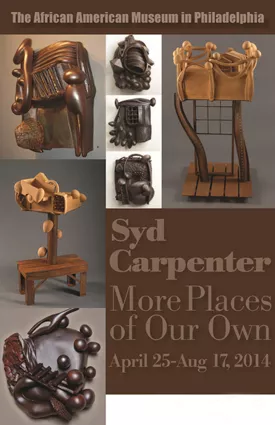New Exhibit by Artist Syd Carpenter Examines Past and Future of African-American Farmers

WHYY Newsworks: African American Museum Cultivates Two Views on the Future of Black Farmers
Is the African-American farmer dying out or about to have a renaissance?
The African American Museum in Philadelphia now has two exhibitions, each with a different perspective about the future of the black farmer. The fourth-floor gallery of the museum has sprouted with a field of garden sculptures created by Syd Carpenter. Each piece, made of ceramic and steel, represents a particular farm she visited during a driving tour of Georgia and South Carolina. Carpenter, a professor at Swarthmore College, has been researching African-American farming and gardening for several years, since she learned her own grandmother was a famous "victory" gardener in Pittsburgh during World War II.
"It was well known for its beauty and production," said Carpenter, who keeps a lush urban garden of her own at her studio in Mount Airy. "That struck a chord. I didn't know I had that history."
Carpenter traces the conflicted relationship African-Americans have had with farming to slavery and emancipation, when newly freed slaves were sometimes the most experienced farmers, through the tumult of Reconstruction, and into the Great Migration of the early 20th century, when black farmers left agriculture in the South, moving into Northern cities to find better work.
"After the Great Migration, people were leaving the land to find better lives in an urban setting. Other people stayed," said Carpenter. "I was curious about who stayed. All these folks who stayed, endured the issues around Jim Crow, the burdens and oppression, at the same time they were enriched lives because they held onto the land." ...
Carpenter's sculptures are abstract portraits of individual farms. She assembled shapes distinctive to each place that capture the spirit of that farm. There are warped steel signposts, chicken wire, and peaked barn roofs.
The shapes often conflict with each other, with the hard edges of machinery sharing space with the soft, natural curves of, say, an egg. They imply the work - sometimes violent work - required to manipulate nature into a productive farm. The pieces are portraits of farms like that of Elbert and Albert Ward, twins who raise cattle; Pearl Fryer, a renowned topiary artist in South Carolina; and the Williams Muscadine vineyard, where the Williams family has been raising grapes for 90 years. ...
"The 2007 agricultural census says there are more African-American farmers since 2001. There has been an incremental increase," said Carpenter. "If you let the narrative end with those photos, it's negative. But come up to my show, and you see that is not the case."
Syd Carpenter is a professor of studio art at Swarthmore College, specializing in ceramics. Her exhibit, More Places of Our Own, is on display at the African American Museum in Philadelphia from April 25 to August 17.



